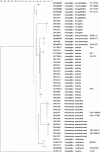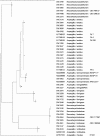Aspergillus section Fumigati: antifungal susceptibility patterns and sequence-based identification
- PMID: 18212093
- PMCID: PMC2292508
- DOI: 10.1128/AAC.00942-07
Aspergillus section Fumigati: antifungal susceptibility patterns and sequence-based identification
Abstract
This study analyzed 28 Aspergillus strains belonging to the section Fumigati that were isolated from clinical samples in Spain. All isolates sporulated slowly and were unable to grow at 48 degrees C. Phylogenetic analysis based on sequencing of partial sequences of the beta-tubulin and rodlet A genes was used to classify the 28 strains into six different clades (Neosartorya hiratsukae, Neosartorya pseudofischeri, Aspergillus viridinutans, Aspergillus lentulus, Aspergillus fumigatiaffinis, and Aspergillus fumisynnematus). Antifungal susceptibility testing showed heterogeneous patterns and grouped the strains together by species. Most A. lentulus and A. fumigatiaffinis isolates showed high MICs of amphotericin B (geometric mean [GM] MICs, >or=4.5 microg/ml), itraconazole (GM MICs, >or=6 microg/ml), voriconazole (GM MICs, >or=3 microg/ml), and ravuconazole (GM MICs, >or=3 microg/ml); N pseudofischeri and A. viridinutans showed high MICs of itraconazole (GM MICs, >or=8 microg/ml), voriconazole (GM MICs, >or=3.33 microg/ml), and ravuconazole (GM MICs, >or=2 microg/ml); and N. hiratsukae and A. fumisynnematus were susceptible to all the antifungals tested. In conclusion, a number of different species whose morphological features resemble those of Aspergillus fumigatus could succeed in producing invasive infections in the susceptible host. In addition, some of them showed high MICs for most of the antifungals available for the treatment of patients infected with these organisms. The epidemiology and clinical relevance of these species should therefore be addressed.
Figures


References
-
- Alcazar-Fuoli, L., E. Mellado, G. Garcia-Effron, M. J. Buitrago, J. F. Lopez, J. O. Grimalt, M. Cuenca-Estrella, and J. L. Rodriguez-Tudela. 2006. Aspergillus fumigatus C-5 sterol desaturases (Erg3A and Erg3B): role in sterol biosynthesis and antifungal drugs susceptibility. Antimicrob. Agents Chemother. 50:453-460. - PMC - PubMed
Publication types
MeSH terms
Substances
Associated data
- Actions
- Actions
- Actions
- Actions
- Actions
- Actions
- Actions
- Actions
- Actions
- Actions
- Actions
- Actions
- Actions
- Actions
- Actions
- Actions
- Actions
- Actions
- Actions
- Actions
- Actions
- Actions
- Actions
- Actions
- Actions
- Actions
- Actions
- Actions
- Actions
- Actions
- Actions
- Actions
- Actions
- Actions
- Actions
- Actions
- Actions
- Actions
- Actions
- Actions
- Actions
- Actions
- Actions
- Actions
- Actions
- Actions
- Actions
- Actions
- Actions
- Actions
- Actions
- Actions
- Actions
- Actions
- Actions
- Actions
- Actions
- Actions
- Actions
- Actions
- Actions
- Actions
- Actions
- Actions
- Actions
- Actions
LinkOut - more resources
Full Text Sources

